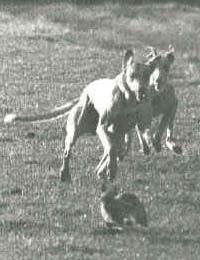
| Lurcher Coursing |
|
Coursing
the wild brown hare is the oldest of all the field sports. There
are two types of lurcher coursing; competitive and non-competitive.
Non-competitive coursing or open field coursing takes place all
over the country every weekend during the winter for sport, for
pest control or to get a hare for the pot. There are many graduations
between competitive and non-competitive coursing. For instance,
coursing matches may take place within non-competitive coursing,
where two lurchermen simply go for a walk in order to test their
dogs against each other, the winner being the dog that catches
the hare.
Contrary to popular belief, hares are not enclosed in any way, they are coursed on the land where they live and are familiar with. Indeed, hares blend into their surroundings so well that lurchermen often talk of 'having to find a hare'. Beaters, people who drive a hare towards the dogs are never used in lurcher coursing. A typical lurcher-coursing event would entail lurchermen walking line abreast, with their dogs, across the fields, when a hare is found the two dogs closest to the hare are slipped. |
 Greyhounds coursing under NCC rules. |
||||||||||||
|
In open field coursing a useful lurcher
would take one in five hares, this ratio is fairly constant so
the mortality rate from lurcher coursing would seldom exceed 20%
of the hares on the ground. This should be compared to other forms
of pest control such as shooting or netting at night which are
said to be 98% effective.
Perhaps the most popular type of coursing is open-field, one for the pot, where a lurcherman allows the lurcher to hunt the wild brown hare. When a hare is found, the lurcher courses the hare. The hare is either caught by the dog or, as more often happens, evades the dog using its speed, stamina and superior turning ability and lives to run another day. A typical open-field course. I hope you don't mind my taking you back twenty years to a day when I climbed a stone wall on the crest of the hill and there before me was a large, steep sided valley. Scanning the valley for any sign of life, I noticed a hare directly across the valley, possibly half a mile from where I was standing. The hare was scratching around in the snow, looking for a root. The brownish red of the hare stood out against the pure white of the snow and made the hare look as though she was only in the next field but I wasn't deceived. I'd walked the land a hundred times and knew the half-mile was more like three-quarters when the curve of the valley floor was taken into consideration. The lurcher saw the hare too. My lurcher, Pockets, saw the hare too. However, he didn't give chase. He studied the hare and waited, wise old lurcher that he was. With ears pricked and with the hare firmly fixed in his gaze, Pockets studied the hare. Then in a low voice I gave the command 'go-on'. I didn't have to repeat myself. He set off down the side of the valley at no more than a forced walk. At the base of the valley he hopped over a dry stone wall and increased his pace to a canter, that's if a dog can canter. Up the field he went, still at the canter. The hare must have been unsighted until he jumped the next wall, which put Pockets in the same field as the hare. Now time dims even the keenest memory but I don't believe the dog increased his pace even though he was now no more than a couple of hundred yards from the hare. He kept his cool. The Hare sat up. The hare sat up, and there was a moment of indecision before she set off across the field. Now the hare didn't put her ears back and fly. Oh, she was running hard, right enough, but not flat out and neither was the lurcher. He kept his pace too. The hare used the slope of the hill to advantage for while the dog was running uphill she made down the valley side, roughly in my direction. Pockets put on another gear and closed on the hare. Now the course really was on. An impressive sight. I watched from my vantage point on the hill as the dog went into a full gallop, I was thrilled to the core to see the hare and dog twisting, tuning, bending against the virgin snow and each time they turned a flurry of snow shot up into the air. What an impressive sight. Now, Pockets 'got-in' behind the hare and after a few turns where the hare made no headway she had no option but to start spinning in an effort to shake off the lurcher. Nine times out of ten, when a hare starts to spin - the contest is all but over. From the pace the dog had set as he got-in behind the hare, he produced an extra bust of speed. This took the hare completely by surprise. The battle was won. |
|||||||||||||
| Country Sports and Country Life is indebted to Gary Hosker , a long time contributor to IHS&F for permission to use material and photographs from his web site : http://www.lurcher.com | |||||||||||||
|
|
|||||||||||||